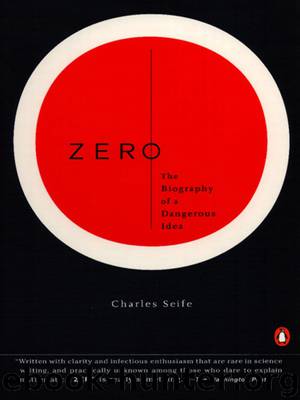Zero: The Biography of a Dangerous Idea by Charles Seife

Author:Charles Seife [Seife, Charles]
Language: eng
Format: epub
Tags: Mathematics, History & Philosophy
ISBN: 9780140296471
Publisher: Penguin Group USA, Inc.
Published: 2000-01-14T14:00:00+00:00
Figure 28: Different motions, all governed by the same differential equation
In 1673 an esteemed German lawyer and philosopher visited London. His name was Gottfried Wilhelm Leibniz. He and Newton would tear the scientific world asunder, though neither would solve the problem of the zeros that suffused calculus.
Nobody knows whether the thirty-three-year-old Leibniz encountered Newton’s unpublished work during his trip to England. But between 1673 and 1676, when Leibniz next visited London, he, too, had developed calculus, although in a slightly different form.
Looking back, it appears that Leibniz formulated his version independently of Newton, though the matter is still being debated. The two had a correspondence in the 1670s, making it very difficult to establish how they influenced each other. However, though the two theories came up with the same answers, their notations—and their philosophies—were very different.
Newton disliked infinitesimals, the little os in his fluxion equations that sometimes acted like zeros and sometimes like nonzero numbers. In a sense these infinitesimals were infinitely small, smaller than any positive number you could name, yet still somehow greater than zero. To the mathematicians of the time, this was a ridiculous concept. Newton was embarrassed by the infinitesimals in his equations, and he swept them under the rug. The os in his calculations were only intermediaries, crutches that vanished miraculously by the end of the computation. On the other hand, Leibniz reveled in the infinitesimal. Where Newton wrote o Leibniz wrote dx—an infinitesimally tiny little piece of x. These infinitesimals survived unchanged throughout Leibniz’s calculations; indeed the derivative of y with respect to x was not the infinitesimal-free ratio of fluxions / but the ratio of infinitesimals dy/dx.
With Leibniz’s calculus, these dys and dxs can be manipulated just like ordinary numbers, which is why modern mathematicians and physicists usually use Leibniz’s notation rather than Newton’s. Leibniz’s calculus had the same power as Newton’s, and thanks to its notation, even a bit more. Nevertheless, underneath all the mathematics, Leibniz’s differentials still had the same forbidden 0/0 nature that plagued Newton’s fluxions. As long as this flaw remained, calculus would be based upon faith rather than logic. (In fact, faith was very much on Leibniz’s mind when he derived new mathematics, such as the binary numbers. Any number can be written as a string of zeros and ones; to Leibniz, this was the creation ex nihilo, the creation of the universe out of nothing more than God/1 and void/0. Leibniz even tried to get the Jesuits to use this knowledge to convert the Chinese to Christianity.)
It would be many years before mathematicians began to free calculus from its mystical underpinnings, for the mathematical world was busy fighting over who invented calculus.
There is little doubt that Newton came up with the idea first—in the 1660s—but he did not publish his work for 20 years. Newton was a magician, theologian, and alchemist as well as a scientist (for instance, he used biblical texts to conclude that the second coming of Christ would occur around 1948) and many of his views were heretical.
Download
This site does not store any files on its server. We only index and link to content provided by other sites. Please contact the content providers to delete copyright contents if any and email us, we'll remove relevant links or contents immediately.
The Infinite Retina by Robert Scoble Irena Cronin(6043)
Harry Potter and the Cursed Child: The Journey by Harry Potter Theatrical Productions(4425)
The Sports Rules Book by Human Kinetics(4265)
Molly's Game: From Hollywood's Elite to Wall Street's Billionaire Boys Club, My High-Stakes Adventure in the World of Underground Poker by Molly Bloom(3471)
A Knight of the Seven Kingdoms by George R R Martin(3173)
Quidditch Through the Ages by J.K. Rowling(3051)
How To by Randall Munroe(3012)
Quidditch Through the Ages by J K Rowling & Kennilworthy Whisp(2921)
Flowers For Algernon by Daniel Keyes(2900)
Quidditch Through the Ages by Kennilworthy Whisp by J.K. Rowling(2807)
Stacked Decks by The Rotenberg Collection(2790)
Quidditch through the Ages by J. K. Rowling(2755)
Quidditch Through The Ages by J. K. Rowling(2720)
776 Stupidest Things Ever Said by Ross Petras(2675)
Ready Player One: A Novel by Ernest Cline(2634)
What If?: Serious Scientific Answers to Absurd Hypothetical Questions by Randall Munroe(2624)
Beautiful Oblivion by Jamie McGuire(2555)
The Book of Questions: Revised and Updated by Gregory Stock Ph.d(2500)
Champions of Illusion by Susana Martinez-Conde & Stephen Macknik(2401)
